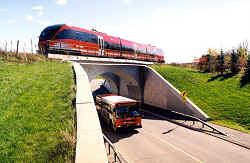|
|
 |
Showcase Proposals - Proposal Summaries
City of Ottawa
Carling Avenue, Towards Achieving KYOTO Objectives
The City of Ottawa proposes a number of strategies to make a conventional arterial road corridor more supportive of walking, cycling and public transit, encouraging more sustainable travel patterns and reducing greenhouse gas emissions from transportation.
Background

The City of Ottawa is home to over 820,000 people, and its new Transportation Master Plan calls for a significant increase in travel by sustainable modes. This long-term challenge sets the stage for a showcase proposal to reshape a busy arterial road.
The subject portion of Carling Avenue runs 8.5 kilometres from Pinecrest Road in the western suburbs to Bronson Avenue at the edge of downtown. The six-lane divided road successfully moves vehicles, but impairs neighbourhood cohesion and the safety of pedestrians and cyclists. It carries several major bus routes, but has only a basic sidewalk and no dedicated cycling lanes. Office towers, shopping malls, residential neighbourhoods, schools, hospitals, parks, hotels and retail stores line the road.
The showcase would integrate five strategies through a single corridor vision, a multimedia communications plan, and a public outreach strategy to maximize public understanding and involvement.
[Back to top]
Transit enhancements
The showcase would improve transit service along Carling Avenue by:
-
Increasing service levels and attracting new riders through the addition of two low-floor buses, running on ultra low sulphur diesel fuel, to the main corridor route
-
Designating curb lanes as reserved bus lanes, giving priority to buses at traffic signals, and upgrading bus stops along a congested one-kilometre stretch of the corridor
-
Relocating bus stops and shelters to better serve major destinations
-
Creating a visual identity for the corridor’s transit shelters, signs, maps, Web information and perhaps the buses themselves
-
Creating weather-protected pedestrian links to major destinations
-
Creating 22 mini-stations with enclosed shelters, bike racks and real?time bus arrival information
[Back to top]
Cycling facilities
The showcase would improve the availability, safety and quality of cycling routes at priority locations. The improvements would create a cohesive system out of the existing patchwork of cycling facilities. Measures would include:
-
Adding new cycling lanes, signs, pavement markings and curb cuts
-
Filling gaps in the pathway network
-
Improving links to destinations
-
Adding and upgrading traffic signals to enable cyclist crossings

[Back to top]
Walking facilities
The showcase would improve the availability, safety and quality of walking facilities by:
-
Auditing sidewalks and pathways along the corridor and removing any barriers
-
Promoting green and pedestrian-friendly streetscapes by including trees, street furniture and public art in redevelopment projects
-
Providing visual cues and surface treatments to help visually-impaired pedestrians find their way
-
Ensuring frequent, continuous pedestrian connections to and between destinations
-
Ensuring that the design and operation of traffic signals support walking, especially by seniors and persons with disabilities

[Back to top]
Transportation demand management
Transportation demand management (TDM) measures encourage people to travel by modes other than the single-occupant automobile, to travel outside peak periods, and to make fewer and shorter trips. Related showcase measures would include:
-
Offering site audits, survey cost-sharing, training, promotion and awards to employers
-
Encouraging a new private-sector based transportation management association (TMA) in a multi-tenant commercial centre
-
Helping schools improve travel safety and minimize automobile use by staff and students
-
Adding multimodal travel information displays at rapid transit stations, apartments and office buildings
-
Distributing sustainable travel information for tourists at hotels and motels in the corridor
-
Partnering with sports stores to promote active transportation
-
Going door-to-door to provide customized advice on walking, cycling and transit use to interested households
-
More secure bicycle parking at apartment buildings and major employment centres
-
Applying land use design guidelines to development approvals in the corridor (e.g. minimum three-storey height, direct pedestrian connections, parking beside or behind buildings)
-
Encouraging car dealers to showcase low-emission and hybrid vehicles along the street frontage
[Back to top]
Supportive land use
The showcase would help developers include sustainable transportation measures in new developments. Measures would include:
-
Guidelines for building massing, height, siting and organization to enhance community integration and encourage parking lot infill
-
Vehicle access and parking guidelines to promote shared parking and driveways, parking lots behind or beside buildings, and off-street loading areas
-
Integration with cycling and transit facilities
-
Quality pedestrian connections between sidewalks and destinations
-
Use of incentives such as reduced development fees, flexible zoning or reduced parking requirements to encourage mixed-use developments
-
Partnerships with two planned developments, one a hospital and the other a mixed-use commercial/residential complex

[Back to top]
Expected benefits
No estimate is available of the expected reduction in greenhouse gas emissions from the showcase. Other benefits would include:
-
Reductions in overall air emissions, congestion, delay, and public and private costs
-
Increases in safety, community cohesion, public awareness and municipal capacity
[Back to top]
Impact assessment
Showcase impacts would be measured primarily through surveys of corridor residents and workers, annual multimodal traffic counts, and air quality measurements. Indicators could include:
-
Modal shifts or reduced traffic volumes
-
Ambient and in-vehicle air quality
-
Congestion levels, travel times and queue lengths
-
Transit ridership, costs, travel times and service reliability
-
Collision volumes, rates and injuries
[Back to top]
Partners
The contributing partners in this showcase would include:
[Back to top]
Cost
The proposed showcase cost of $13.3 million is divided as follows:
-
Transit enhancements — $7.4 million
-
Cycling enhancements — $1.1 million
-
Walking enhancements — $1.1 million
-
Transportation demand management — $0.5 million
-
Supportive land use — $0.1 million
-
Integration, communications, implementation — $2.5 million
-
Staffing — $0.6 million
[Back to top]
Note: This information reflects the proposal as submitted by the applicant, and does not reflect the views of Transport Canada.
|

